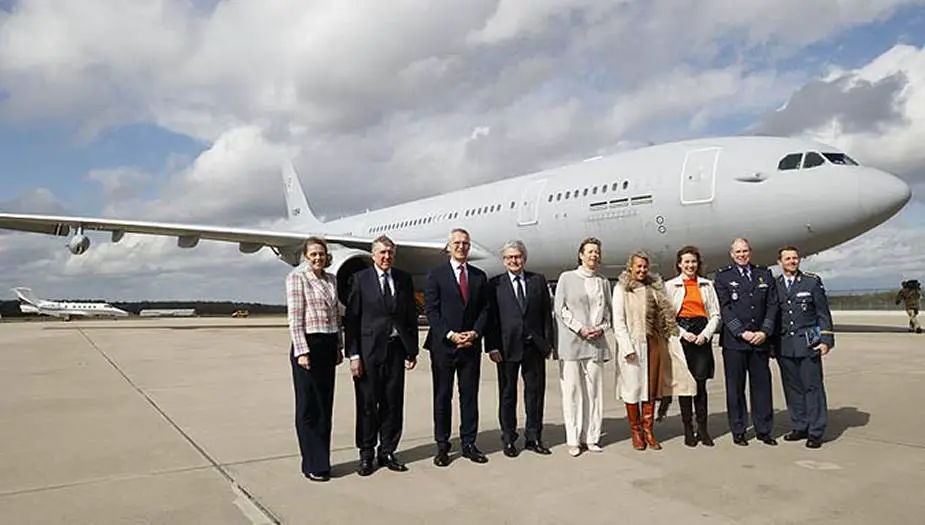NATO Secretary General Jens Stoltenberg on 23 March 2023 welcomed the launch of a multinational Multi-Role Tanker Transport aircraft fleet (MRTT) that is "now ready for a full range of missions" at Eindhoven Air Base in the Netherlands.
Follow Air Recognition on Google News at this link
 “These aircraft will provide us with world-class air-to-air refuelling, air transport and air medical evacuation capabilities. Tanker aircraft is the backbone of Allied air power,” Mr Stoltenberg said (Picture source: NATO)
“These aircraft will provide us with world-class air-to-air refuelling, air transport and air medical evacuation capabilities. Tanker aircraft is the backbone of Allied air power,” Mr Stoltenberg said (Picture source: NATO)
The Secretary General attended a ceremony to mark the initial operational capability of the aircraft fleet, together with Dutch Minister of Defence, Kajsa Ollongren, European Commissioner for the Internal Market, Thierry Breton, and officials from five other nations participating in the project: Belgium, Czechia, Germany, Luxembourg and Norway.
“These aircraft will provide us with world-class air-to-air refuelling, air transport and air medical evacuation capabilities. Tanker aircraft is the backbone of Allied air power,” Mr Stoltenberg said. “Most importantly, the fleet has already proven its value. Since Russia’s brutal invasion of Ukraine, these tanker transport aircraft have helped to protect NATO’s eastern flank,” he added.
Last year alone, the fleet flew more than 500 missions, refuelling hundreds of NATO fighter jets to keep Allied airspace safe. These aircraft have also supported the evacuation of civilians and refugees from Afghanistan, deployed to the Indo-Pacific for exercises with key NATO partners, including Australia, and later this year, they will deploy to the Middle East to support operations against ISIS.
The European Defence Agency, the Organisation for Joint Armament Cooperation, and the NATO Support and Procurement Agency worked together to develop this state-of-the-art fleet. “This is an excellent example of how NATO and the EU are working together to deliver critical capabilities for our members,” Mr Stoltenberg said. “This also demonstrates that European Allies are stepping up for their defence and strengthening our shared security,” he concluded.
Currently, seven aircraft from the fleet are in service. Two more are expected to join in 2024, with the tenth aircraft scheduled for delivery at the end of 2026.
Multi-Role Tanker Transport (MRTT)
A Multi-Role Tanker Transport (MRTT) aircraft is a military aircraft designed to provide multiple functions to air forces. Specifically, it is capable of aerial refueling, transport of cargo and passengers, and medical evacuation operations.
MRTTs are typically modified versions of commercial airliners, such as the Boeing 767 or Airbus A330. They are equipped with additional fuel tanks and pumps to allow them to refuel other aircraft in flight, and they have a cargo hold that can be configured to transport cargo, troops, or medical patients. The MRTT is a highly versatile aircraft that can be used in a variety of roles: it can provide air-to-air refueling to fighter aircraft, extending their range and endurance for missions. It can transport cargo and personnel to remote locations or provide rapid deployment of troops in times of crisis. The medical evacuation role allows the aircraft to provide critical care to wounded soldiers and civilians in disaster zones.
MRTTs are used by a number of air forces around the world, including the Royal Australian Air Force, Royal Air Force, Royal Saudi Air Force, and others. They are a critical component of modern military air power, providing flexibility and capability to air forces in a variety of roles.
Technical details
* Aerial Refueling Capability: MRTTs are equipped with a hose-and-drogue or boom refueling system that can transfer fuel to other aircraft in flight. The hose-and-drogue system uses a flexible hose that trails behind the tanker, while the boom system uses a rigid, telescoping tube to transfer fuel.
* Fuel Capacity: MRTTs have significantly larger fuel capacity than commercial airliners they are based on. The additional fuel tanks installed in MRTTs allow them to carry up to 100,000 lbs (45,000 kg) of fuel.
* Cargo Capacity: MRTTs have a large cargo hold that can be configured to transport cargo, troops, or medical patients. The cargo hold can accommodate up to 37 pallets, or 270 passengers in a typical airline configuration.
* Range: MRTTs have a longer range than commercial airliners due to their additional fuel capacity. Depending on the specific aircraft and mission, MRTTs can fly up to 8,000 nautical miles (14,816 km) without refueling.
* Engines: MRTTs are typically powered by two high-bypass turbofan engines, such as the General Electric CF6 or Rolls-Royce Trent 700. These engines provide the necessary thrust to lift heavy aircraft and carry out refueling and transport missions.
* Avionics: MRTTs are equipped with advanced avionics and communications systems to support their multi-role capabilities. They have radar, electronic warfare systems, and satellite communications capabilities to enable them to operate in a range of environments.
* Medical Evacuation Equipment: In the medical evacuation role, MRTTs are equipped with advanced medical equipment, including stretchers, oxygen supplies, and ventilators. The aircraft can provide critical care to up to 40 patients in a single flight.
















